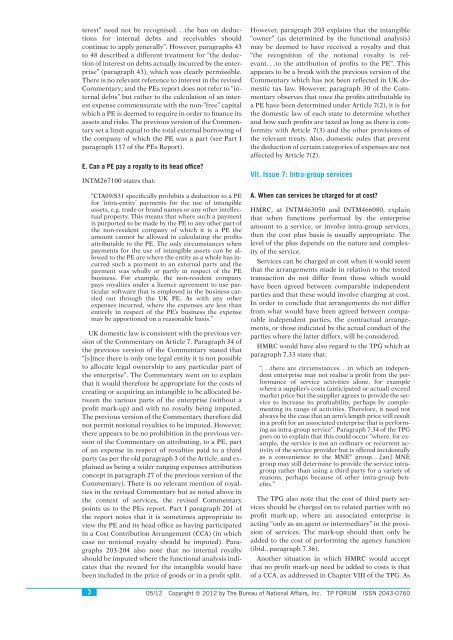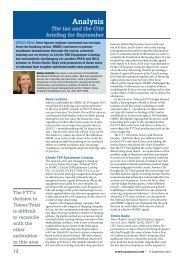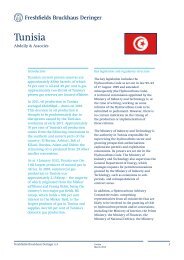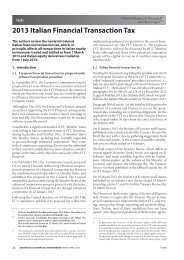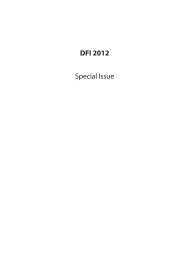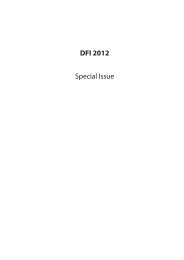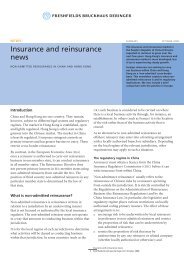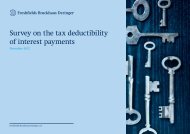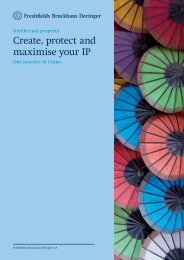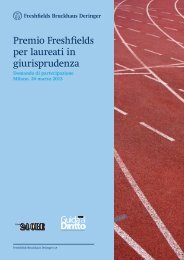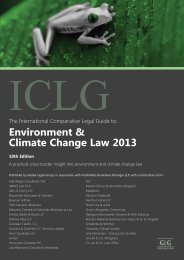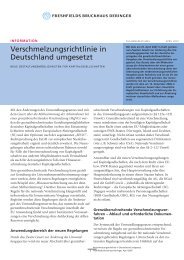XPP-PDF Support Utility - Freshfields
XPP-PDF Support Utility - Freshfields
XPP-PDF Support Utility - Freshfields
You also want an ePaper? Increase the reach of your titles
YUMPU automatically turns print PDFs into web optimized ePapers that Google loves.
terest’’ need not be recognised. . .the ban on deductionsfor internal debts and receivables shouldcontinue to apply generally’’. However, paragraphs 43to 48 described a different treatment for ‘‘the deductionof interest on debts actually incurred by the enterprise’’(paragraph 43), which was clearly permissible.There is no relevant reference to interest in the revisedCommentary; and the PEs report does not refer to ‘‘internaldebts’’ but rather to the calculation of an interestexpense commensurate with the non-’’free’’ capitalwhich a PE is deemed to require in order to finance itsassets and risks. The previous version of the Commentaryset a limit equal to the total external borrowing ofthe company of which the PE was a part (see Part Iparagraph 117 of the PEs Report).E. Can a PE pay a royalty to its head office?INTM267100 states that:‘‘CTA09/S31 specifically prohibits a deduction to a PEfor ‘intra-entity’ payments for the use of intangibleassets, e.g. trade or brand names or any other intellectualproperty. This means that where such a paymentis purported to be made by the PE to any other part ofthe non-resident company of which it is a PE theamount cannot be allowed in calculating the profitsattributable to the PE. The only circumstances whenpayments for the use of intangible assets can be allowedto the PE are where the entity as a whole has incurredsuch a payment to an external party and thepayment was wholly or partly in respect of the PEbusiness. For example, the non-resident companypays royalties under a licence agreement to use particularsoftware that is employed in the business carriedout through the UK PE. As with any otherexpenses incurred, where the expenses are less thanentirely in respect of the PE’s business the expensemay be apportioned on a reasonable basis.’’UK domestic law is consistent with the previous versionof the Commentary on Article 7. Paragraph 34 ofthe previous version of the Commentary stated that‘‘[s]ince there is only one legal entity it is not possibleto allocate legal ownership to any particular part ofthe enterprise’’. The Commentary went on to explainthat it would therefore be appropriate for the costs ofcreating or acquiring an intangible to be allocated betweenthe various parts of the enterprise (without aprofit mark-up) and with no royalty being imputed.The previous version of the Commentary therefore didnot permit notional royalties to be imputed. However,there appears to be no prohibition in the previous versionof the Commentary on attributing, to a PE, partof an expense in respect of royalties paid to a thirdparty (as per the old paragraph 3 of the Article, and explainedas being a wider ranging expenses attributionconcept in paragraph 27 of the previous version of theCommentary). There is no relevant mention of royaltiesin the revised Commentary but as noted above inthe context of services, the revised Commentarypoints us to the PEs report. Part I paragraph 201 ofthe report notes that it is sometimes appropriate toview the PE and its head office as having participatedin a Cost Contribution Arrangement (CCA) (in whichcase no notional royalty should be imputed). Paragraphs203-204 also note that no internal royaltyshould be imputed where the functional analysis indicatesthat the reward for the intangible would havebeen included in the price of goods or in a profit split.However, paragraph 203 explains that the intangible‘‘owner’’ (as determined by the functional analysis)may be deemed to have received a royalty and that‘‘the recognition of the notional royalty is relevant.. .to the attribution of profits to the PE’’. Thisappears to be a break with the previous version of theCommentary which has not been reflected in UK domestictax law. However, paragraph 30 of the Commentaryobserves that once the profits attributable toa PE have been determined under Article 7(2), it is forthe domestic law of each state to determine whetherand how such profits are taxed as long as there is conformitywith Article 7(3) and the other provisions ofthe relevant treaty. Also, domestic rules that preventthe deduction of certain categories of expenses are notaffected by Article 7(2).Vll. Issue 7: Intra-group servicesA. When can services be charged for at cost?HMRC, at INTM463050 and INTM466080, explainthat when functions performed by the enterpriseamount to a service, or involve intra-group services,then the cost plus basis is usually appropriate. Thelevel of the plus depends on the nature and complexityof the service.Services can be charged at cost when it would seemthat the arrangements made in relation to the testedtransaction do not differ from those which wouldhave been agreed between comparable independentparties and that these would involve charging at cost.In order to conclude that arrangements do not differfrom what would have been agreed between comparableindependent parties, the contractual arrangements,or those indicated by the actual conduct of theparties where the latter differs, will be considered.HMRC would have also regard to the TPG which atparagraph 7.33 state that:‘‘. . .there are circumstances. . .in which an independententerprise may not realise a profit from the performanceof service activities alone, for examplewhere a supplier’s costs (anticipated or actual) exceedmarket price but the supplier agrees to provide the serviceto increase its profitability, perhaps by complementingits range of activities. Therefore, it need notalways be the case that an arm’s length price will resultin a profit for an associated enterprise that is performingan intra-group service’’. Paragraph 7.34 of the TPGgoes on to explain that this could occur ‘‘where, for example,the service is not an ordinary or recurrent activityof the service provider but is offered incidentallyas a convenience to the MNE 6 group. . .[an] MNEgroup may still determine to provide the service intragrouprather than using a third party for a variety ofreasons, perhaps because of other intra-group benefits.’’The TPG also note that the cost of third party servicesshould be charged on to related parties with noprofit mark-up, where an associated enterprise isacting ‘‘only as an agent or intermediary’’ in the provisionof services. The mark-up should then only beadded to the cost of performing the agency function(ibid., paragraph 7.36).Another situation in which HMRC would acceptthat no profit mark-up need be added to costs is thatof a CCA, as addressed in Chapter VIII of the TPG. As3 05/12 Copyright 2012 by The Bureau of National Affairs, Inc. TP FORUM ISSN 2043-0760


